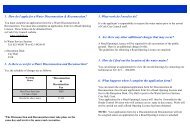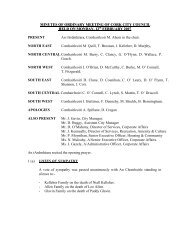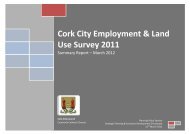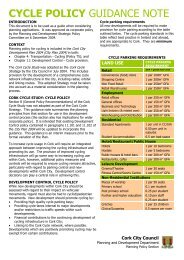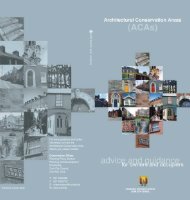Untitled - Cork City Council
Untitled - Cork City Council
Untitled - Cork City Council
You also want an ePaper? Increase the reach of your titles
YUMPU automatically turns print PDFs into web optimized ePapers that Google loves.
Appendix 5 : Guidance on Retail Impact Assessment<br />
the <strong>Cork</strong> Strategic Retail Study 2007, subsequently to be adjusted by the applicant to<br />
reflect the timeframe elapsed between the preparation of the CSRS and that of the<br />
particular Retail Impact Statement.<br />
17. Care should taken to identify specifically the particular types of retailing proposed taking<br />
into account that industry dynamics have resulted in certain stores trading over a range of<br />
formats, including convenience and comparison goods under the one roof. Catchment<br />
areas and turnover ratios therefore, must be applied specifically to the particular format.<br />
Higher order centres have a more extensive catchment reflecting the role in the retail<br />
hierarchy.<br />
18. Within the hierarchy, retail centres compete with other centres of their own type and do<br />
not necessarily compete with upper or lower echelons. A mature hierarchy requires<br />
centres of all types, with a greater number of lower order centres.<br />
19. The design year for a development is a period ranging up to one year after completion of<br />
construction and commencement of trading. This allows settled trading patterns to have<br />
been established. Therefore, it is necessary to take a prudent account when preparing a<br />
Retail Impact Statement, of the period required for procurement of planning permission<br />
(including potential appeals), the period of construction and lettings. It is not necessary<br />
that this period falls within the term of a particularly Retail Strategy, particularly where<br />
there is a longer term strategic expansion envisaged for a particular centre.<br />
20. Estimation of trade diversion is an integral part of the assessment of retail impact and<br />
cumulative impact. It is necessary to show the diversions from each centre to the new<br />
proposal and to substantiate how this is calculated by reference to empirical evidence.<br />
Broad statements of diversions as a proportion of total spending within a catchment area<br />
or as a proportion of the growth in forecast spending generated do not give any<br />
meaningful guidance as to the diversion from individual centres.<br />
21. Cumulative impact refers to the impact of the proposed development along with one or<br />
more existing planning permissions for other retail development in the catchment area of<br />
the proposal. Here it is necessary to account for the joint impact of more than one new<br />
project and also to show the impact of the new proposals on each other.<br />
3



